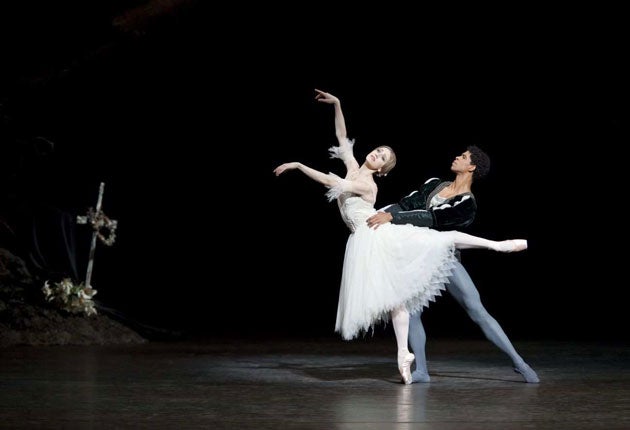Giselle, Royal Opera House, London
Nunez dazzles as Acosta disappoints

Your support helps us to tell the story
From reproductive rights to climate change to Big Tech, The Independent is on the ground when the story is developing. Whether it's investigating the financials of Elon Musk's pro-Trump PAC or producing our latest documentary, 'The A Word', which shines a light on the American women fighting for reproductive rights, we know how important it is to parse out the facts from the messaging.
At such a critical moment in US history, we need reporters on the ground. Your donation allows us to keep sending journalists to speak to both sides of the story.
The Independent is trusted by Americans across the entire political spectrum. And unlike many other quality news outlets, we choose not to lock Americans out of our reporting and analysis with paywalls. We believe quality journalism should be available to everyone, paid for by those who can afford it.
Your support makes all the difference.The Royal Ballet's Marianela Nunez has a sense of delight in her dancing. It makes her a natural for the more optimistic classical roles – mischievous farm-girls or radiant princesses. But it can also work powerfully in tragic roles. As Giselle, a village girl deceived by an aristocratic lover, Nunez starts out glowing with happiness. Then her world falls apart.
Giselle is the most famous of the 19th-century Romantic ballets. Gautier's scenario has madness, men danced to death by vengeful female ghosts, misty glades, love lingering after death. The choreography, by Petipa after Coralli and Perrot, goes from lively village dances to fierce or ethereal dances for the ghostly Wilis.
Nunez is fresh and spontaneous in the ballet's early scenes, without a hint of coyness when she flirts with Albrecht or plays "he loves me not" with a flower's petals. Throughout, her pleasure in movement is unmistakable. Giselle is a heroine who loves to dance, so much so that she's actually told off for it by her mother. Nunez sails through the role's technical demands, enjoying every challenge. The hops on pointe are gleefully light and buoyant.
The village scenes are bright and lively. Laura Morera and Ricardo Cervera dance with crisp precision. Morera is wittily musical in her solo, with quick feet and delicately swaying upper body. There's some lovely banter between Gary Avis's Hilarion and Genesia Rosato as Giselle's mother: their mime conversations have the ease of long friendship.
Rosato sweeps through the tricky mime scene describing the legend of the Wilis, the ghosts of betrayed women. She mimics the Wili queen with sensuous authority, addressing her daughter with over-protective worry. Nunez, watching her, is disturbed by the story, concerned for her mother – but she also feels some teenage embarrassment.
Nunez's Giselle stays happy as long as she can. When Hilarion accuses Albrecht, she won't believe it. She rushes over to him in complete affection and confidence; she isn't even seeking reassurance. Then, as other courtiers start to arrive, about to confirm Hilarion's accusation, she stops dead. Nunez's stillness is extraordinary. You can see the truth hitting her, freezing her where she stands.
The mad scene is a confirmation of that moment. Some Giselles die of a broken heart, others commit suicide. Nunez's Giselle definitely means to stab herself, snatching up Albrecht's sword. Madness gives her a dislocated, doll-like air, interrupted only by physical pain. As she clutches her side, she's human and natural; remembering what has happened, she becomes stiff and disjointed again, detached from the world.
Carlos Acosta is a starry but disappointing Albrecht. His dancing is smooth and confident, his partnering secure, but he's phoning too much of this performance in. Elizabeth McGorian, as his aristocratic fiancée, is so much more vivid in her reaction to Giselle's madness and death.
Peter Wright's heavily naturalistic production cramps the Wili scenes. The draped costumes, and John McFarlane's oppressively detailed forest set, blur the shape and scale of these dances. Boris Gruzin's heavy-handed conducting of the Adam score doesn't help.
The corps dance these scenes with more authority than in recent revivals, but the miss the Wilis' ghostly power. When they dance Hilarion to death, the scene's impact comes from Gary Avis's urgent performance.
Again, Nunez lifts the performance around her. She isn't a naturally ethereal dancer, but makes herself ghostly through the quality of her dancing. The line of her shoulders is mournfully soft; her fast turns look windblown. Coming out of a spin, she slows luxuriantly, floating to a weightless stop. The velvet richness of her movement is unexpected and wonderful.
In repertory until 26 May (020-7304 4000)
Join our commenting forum
Join thought-provoking conversations, follow other Independent readers and see their replies
Comments